There are large regions of the globe where observations indicate there has been no warming (even cooling) during the last decades to century. Climate models rooted in the assumption that fossil fuel emissions drive dangerous warming dismiss these modeling failures and project temperature increases of 3° – 10°C by 2100 for these same regions anyway.
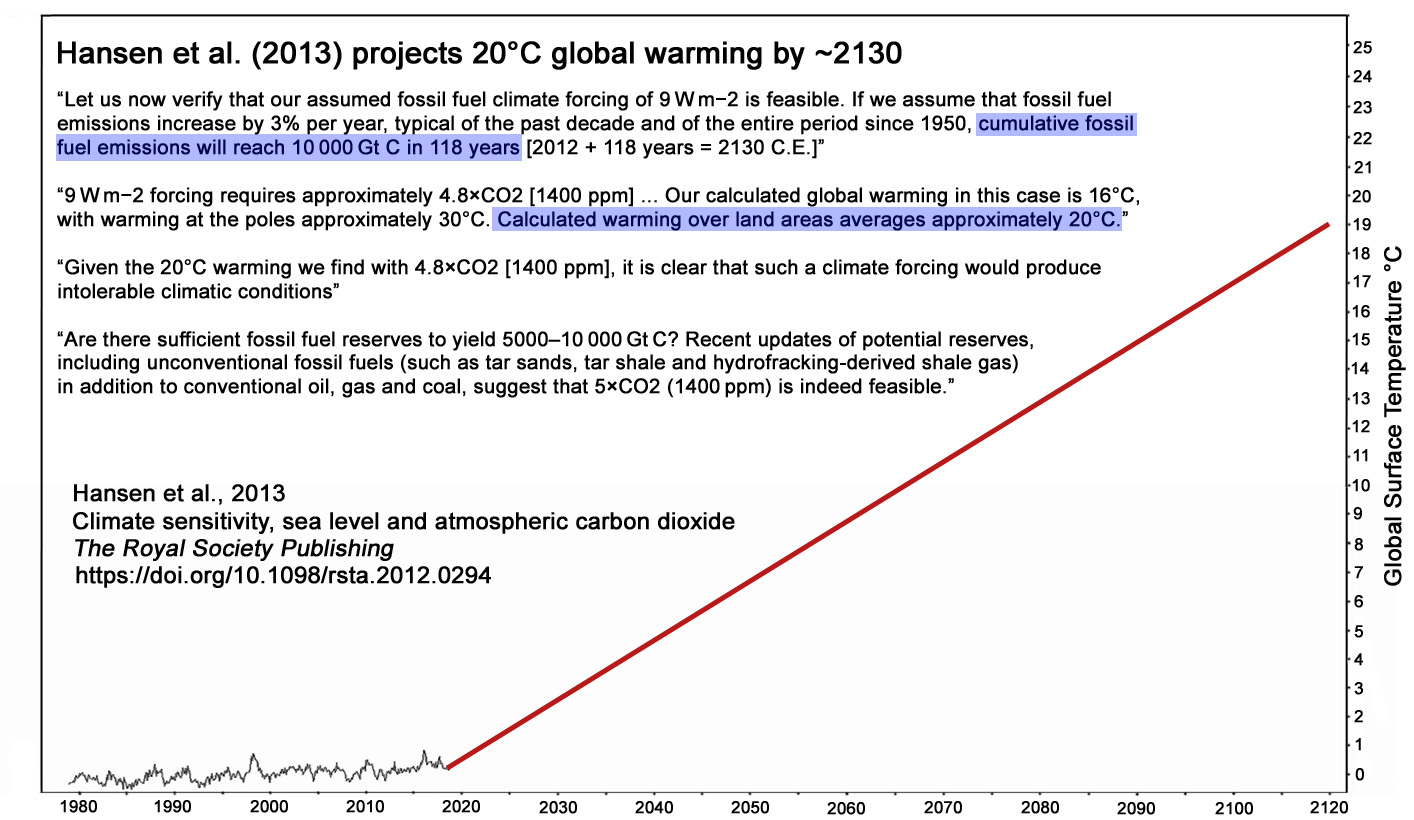
Four decades of Southern Ocean cooling
After warming from the 1940s to the mid-1970s, the Southern Ocean has been cooling since the late-1970s, which has consequently resulted in an increase in sea ice extent (Fan et al., 2014; Purich et al., 2018; Latif et al., 2017; Turney et al., 2017 ).
In their paper entitled “Natural variability of Southern Ocean convection as a driver of observed climate trends”, Zhang et al. (2019) suggest that the Southern Ocean cooling was driven by natural processes.
“Observed Southern Ocean surface cooling and sea-ice expansion over the past several decades are inconsistent with many historical simulations from climate models. Here we show that natural multidecadal variability involving Southern Ocean convection may have contributed strongly to the observed temperature and sea-ice trends.”
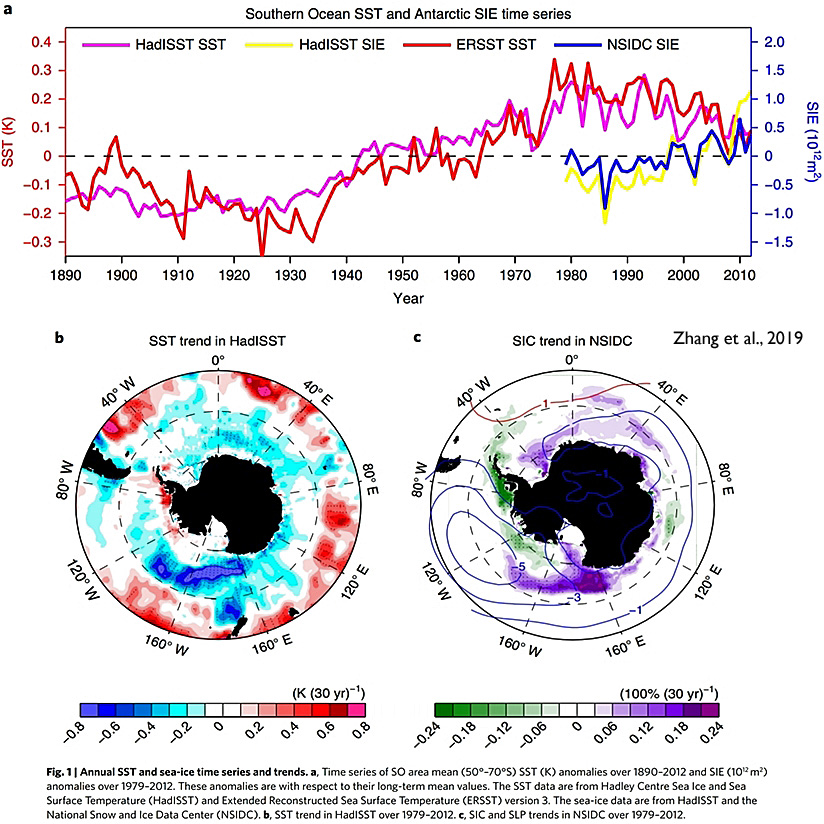
Climate models, in contrast, had projected a rapid warming and significant decreases in sea ice extent during the last few decades.
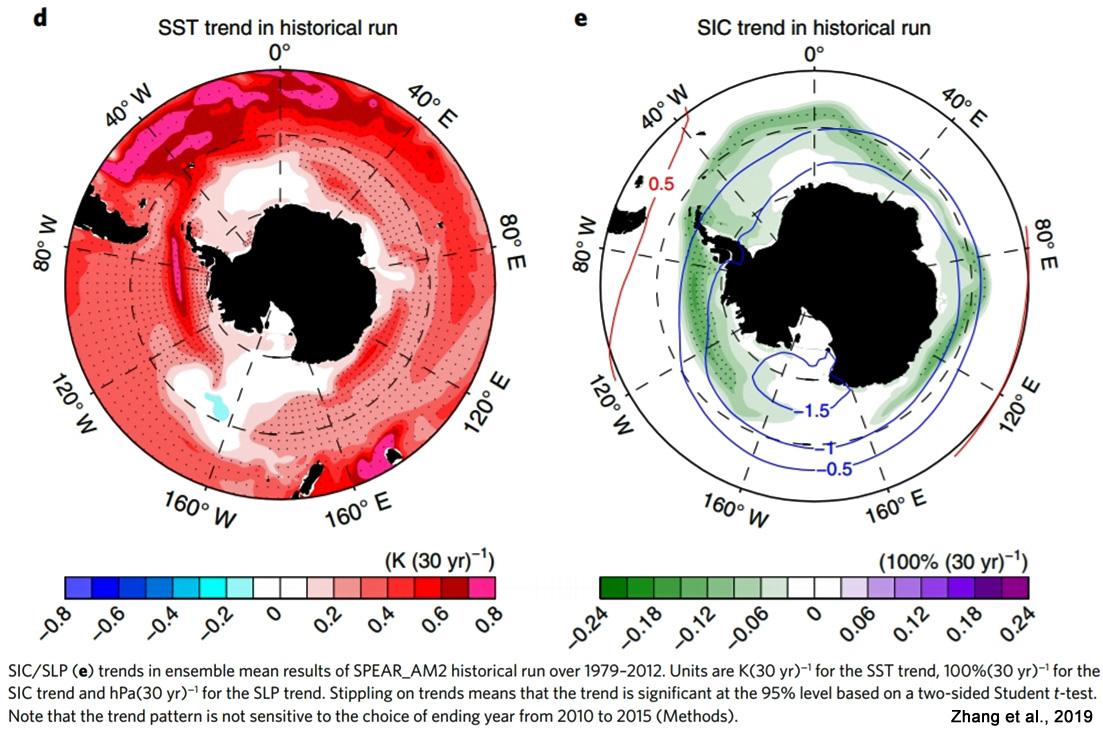
Image(s) Source: Zhang et al., 2019
The East-Central U.S. has been cooling (about -0.6°C) since the 1950s
“We present a novel approach to characterize the spatiotemporal evolution of regional cooling across the eastern U.S. (commonly called the U.S. warming hole), by defining a spatially explicit boundary around the region of most persistent cooling. The warming hole emerges after a regime shift in 1958 where annual maximum (Tmax) and minimum (Tmin) temperatures decreased by 0.46°C and 0.83°C respectively.”

Image Source: Partridge et al., 2018
“From 1910- 1949 (pre-agricultural development, pre-DEV) to 1970-2009 (full agricultural development, full-DEV), the central United States experienced large-scale increases in rainfall of up to 35% and decreases in surface air temperature of up to 1°C during the boreal summer months of July and August … which conflicts with expectations from climate change projections for the end of the 21st century (i.e., warming and decreasing rainfall) (Melillo et al., 2014).”
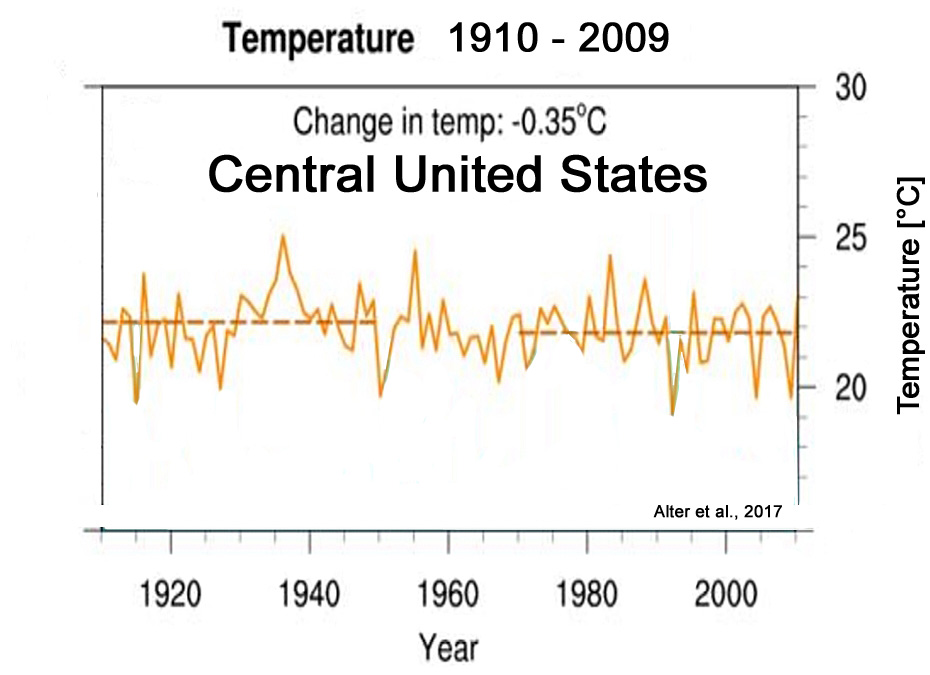
Image Source: Alter et al., 2017
Climate models project 3°C – 10°C warming in the Midwest (U.S.) by 2100
Even though climate models failed to simulate the last 50 to 100 years of temperatures for this region, hindcasting a dramatic warming instead of the observed cooling, the projections for 2100 are still predicated on CO2 emission scenarios (RCP4.5, RCP8.5) as the determinant of regional surface temperatures. Consequently, the regional models project a warming of 3°C – 10°C over the next 80 years.
“For the two most widely used greenhouse gas concentration scenarios, Representative Concentration Pathways (RCP) 4.5 and 8.5 (Moss et al. 2008) (representing “medium” and “high” twenty-first century greenhouse gas concentration trajectories respectively), the Midwestern United States is projected to experience profound changes in climate by 2100, especially for (T). Projections for annual mean T over the Midwestern United States from 31 global climate models (GCMs) for the RCP8.5 scenario show an ensemble mean increase in T of about 6.5 °C (11.7 °F) by 2100 relative to the historical 1971–2000 baseline (Fig. S1) (Byun and Hamlet 2018). The projected change in the annual ensemble mean T for RCP4.5 over the Midwestern United States is about 3.3 °C (5.9 °F) by 2100 relative to the 1971–2000 baseline. The upper tail of the annual mean T distribution, represented by the 97.5th percentile of the 31 GCM projections for RCP8.5 (i.e., a “worst-case” scenario), is nearly 10 °C (18 °F) warmer than the historical baseline by 2100.”
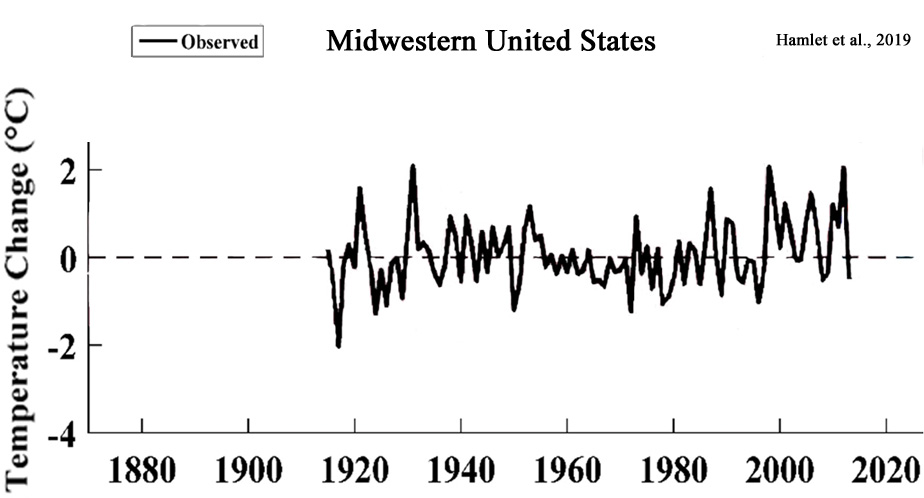
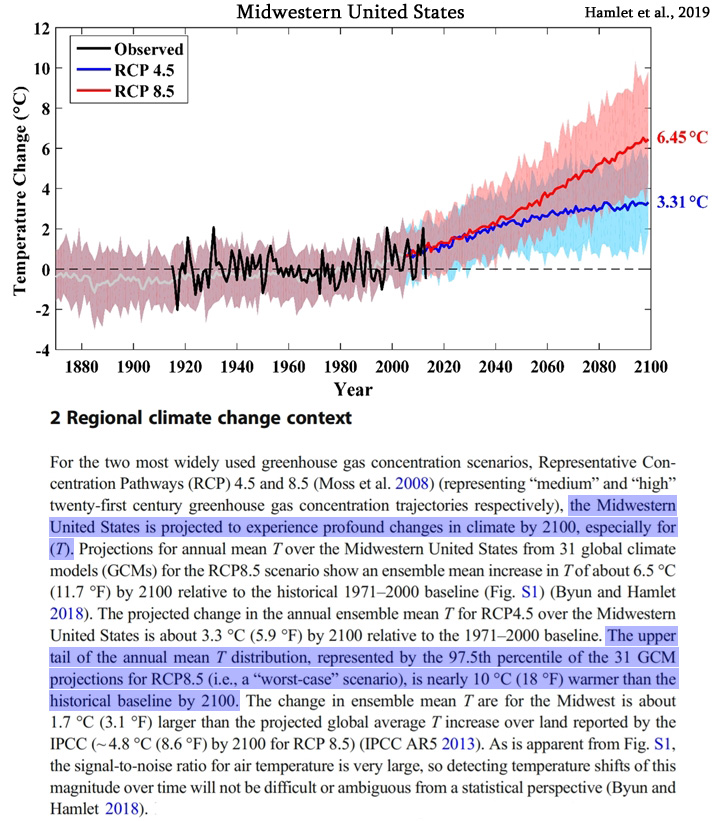
Image(s) Source: Hamlet et al., 2019
The North Atlantic hasn’t warmed since the 1800s
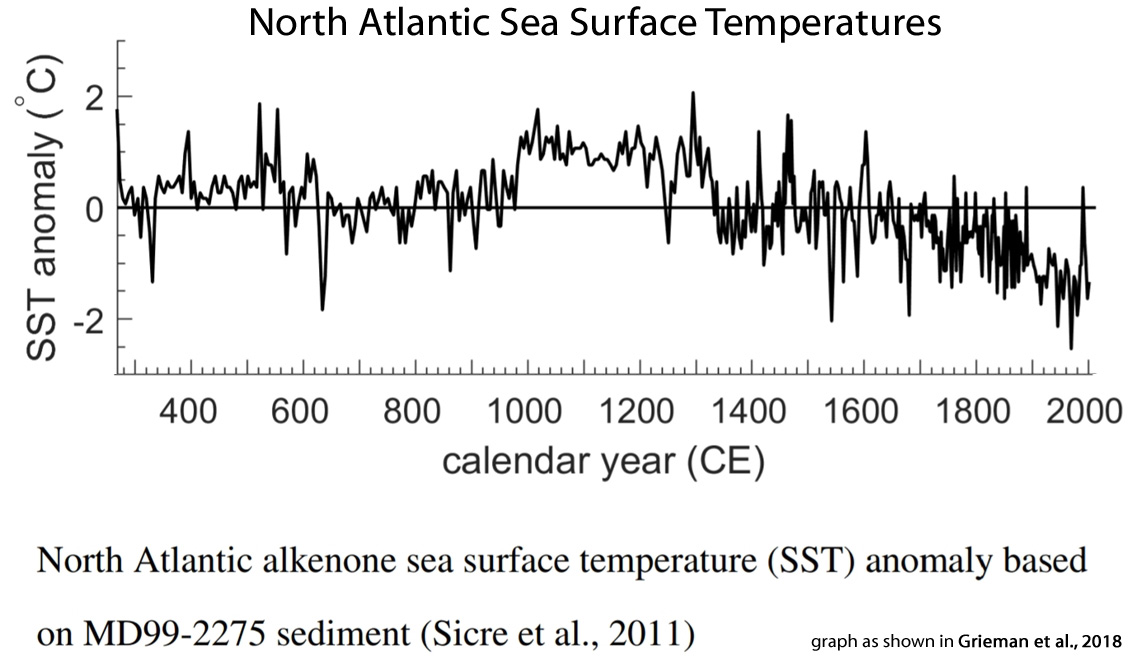
Image Source: Grieman et al., 2018
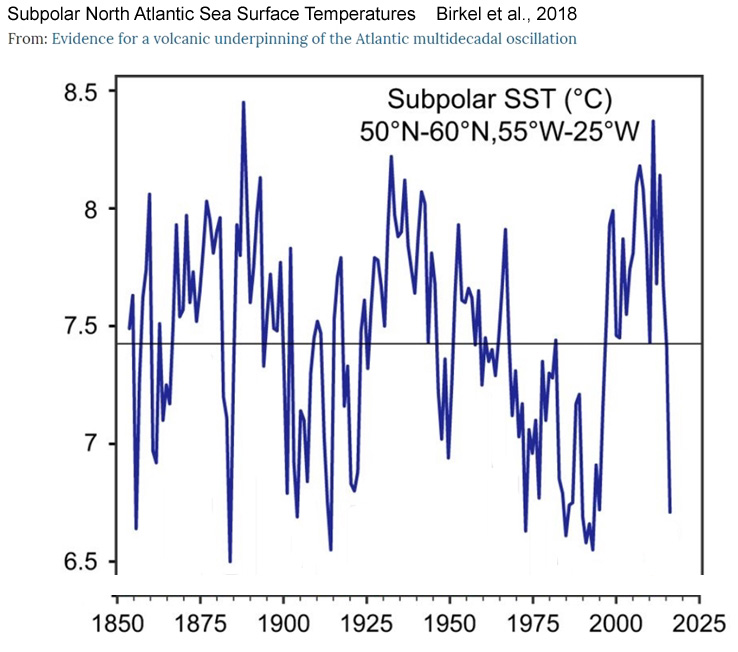
Image Source: Birkel et al., 2018
Climate models project 3°C warming in the North Atlantic by 2100
“Recent studies have documented the development of a warming deficit in North Atlantic sea surface temperatures (SST) both in observations of the current climate (Rahmstorf et al. 2015; Drijfhout et al. 2012) and in future climate simulations (Drijfhout et al. 2012; Marshall et al. 2015; Woollings et al. 2012). This “North Atlantic warming hole” (NAWH) is characterized in the observed record as a region south of Greenland with negative trends in SSTs of 0.8 K century-1 (Rahmstorf et al. 2015). In fully coupled global climate model (GCM) future simulations, the NAWH is seen as a significant deficit in warming within the North Atlantic subpolar gyre (Marshall et al. 2015; Winton et al. 2013; Gervais et al. 2016). This local reduction in future warming is communicated to the overlying atmosphere and may impact atmospheric circulation (Gervais et al. 2016), including the North Atlantic storm track (Woollings et al. 2012).”
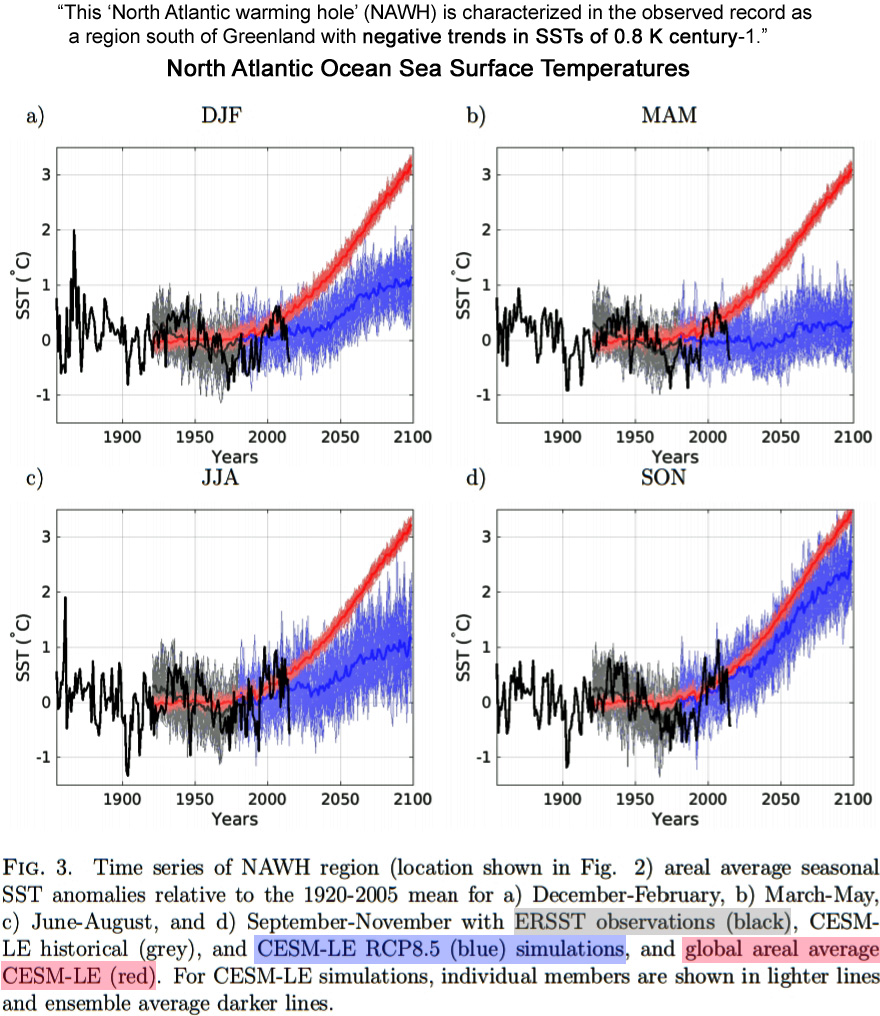
Image Source: Gervais et al., 2018
Hansen (2013): CO2 emissions will cause 20°C of global warming by ~2130
Back in 1989, Dr. James Hansen, the former head of NASA, predicted that New York City’s West Side Highway would be underwater within 20 years due to rapid global warming and the consequent rising sea levels.
A glance at a 2018 image of the West Side Highway indicates that it is still very much above water, no lower than its position in 1936.
A few decades later (2012), Hansen was the lead author of a paper published by The Royal Society (2013) that indicated ever-growing fossil fuel emissions would lead to a nearly five-fold rise in atmospheric CO2 concentrations (to 1,400 ppm) within 118 years.
He then projected this CO2 increase and presumed 9 W m-2 forcing would cause a global surface temperature warming of 20°C by about 2130, with 30°C warming at the poles.
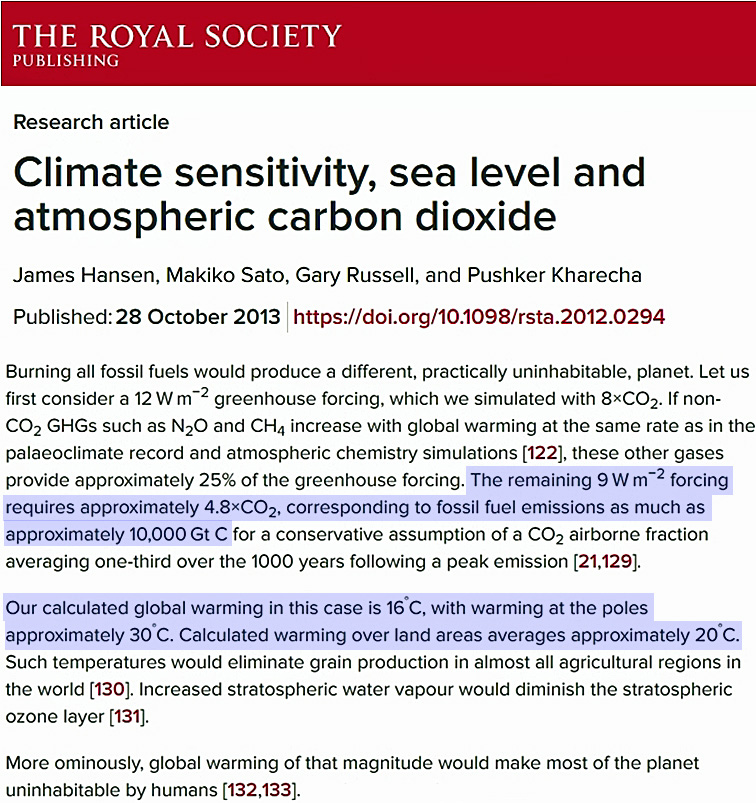
Image Source: Hansen et al., 2013
“Let us now verify that our assumed fossil fuel climate forcing of 9 W m−2 is feasible. If we assume that fossil fuel emissions increase by 3% per year, typical of the past decade and of the entire period since 1950, cumulative fossil fuel emissions will reach 10 000 Gt C in 118 years [2012 + 118 years = ~2130 C.E.] … [T]he fossil fuel source required to yield a 9 W m−2 forcing may be closer to 5000 Gt C, rather than 10 000 Gt C.”
“9 W m−2 forcing requires approximately 4.8×CO2 [1400 ppm] … Our calculated global warming in this case is 16°C, with warming at the poles approximately 30°C. Calculated warming over land areas averages approximately 20°C. … Such temperatures would eliminate grain production in almost all agricultural regions in the world. Increased stratospheric water vapour would diminish the stratospheric ozone layer. More ominously, global warming of that magnitude would make most of the planet uninhabitable by humans.”
“Given the 20°C warming we find with 4.8×CO2 [1400 ppm], it is clear that such a climate forcing would produce intolerable climatic conditions even if the true climate sensitivity is significantly less than the Russell sensitivity, or, if the Russell sensitivity is accurate, the CO2 amount required to produce intolerable conditions for humans is less than 4.8×CO2 [1400 ppm].”
“Are there sufficient fossil fuel reserves to yield 5000–10 000 Gt C? Recent updates of potential reserves, including unconventional fossil fuels (such as tar sands, tar shale and hydrofracking-derived shale gas) in addition to conventional oil, gas and coal, suggest that 5×CO2 (1400 ppm) is indeed feasible.”
Given the documented modeled forecast failures and lack of extreme or dangerous warming in recent decades, is there good reason to assume that Hansen’s prediction of a 20°C warming over the next 110 years will be realized?
At what point do modeling failures lead to a reconsideration of the forcing mechanisms?
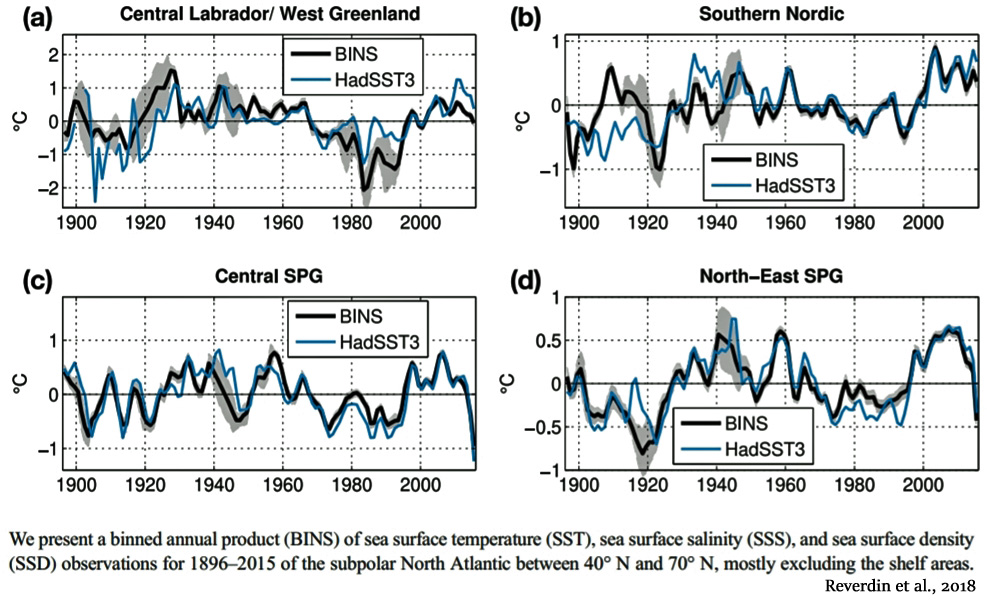
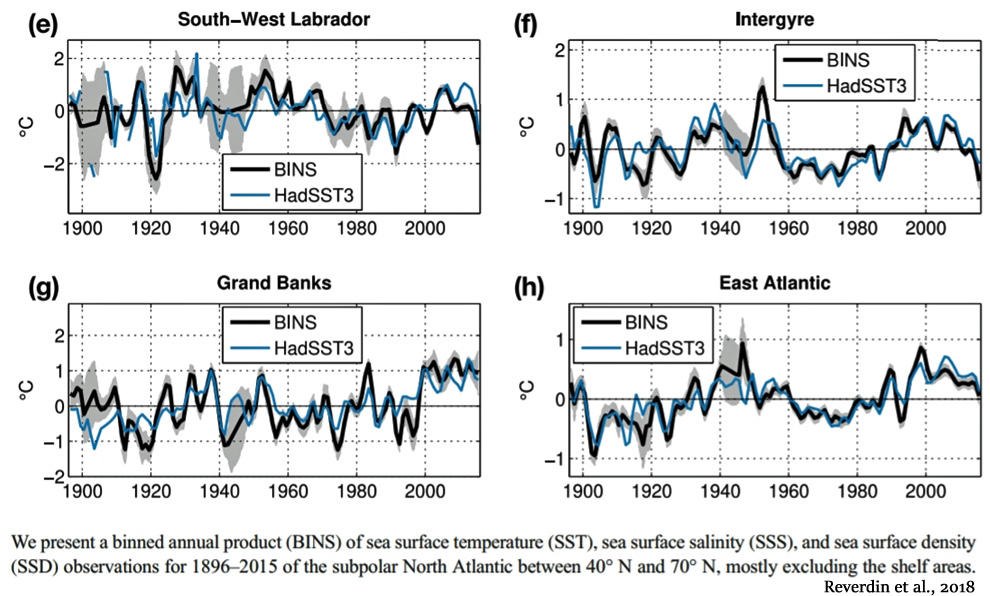





“At what point do modeling failures lead to a reconsideration of the forcing mechanisms?”
When the flow of money stops.
When the conditions for this predictions are met, why not? It’s physics. Which one of the laws of physics do you think is applied wrong here?
Kenneth, you deleted the part about not understanding exponential functions/timeseries, sneaky skeptic you 😉 [Refrain from referring to skeptics as “climate deniers” in the same sentence and these portions of your comments will not be deleted.]
How else would you explain the very first graph in this post?
P.S.: The headline isn’t correct. At best it could read “Observations: No Warming in some regions In The Last 40-100 Years.” This reminds of the times you wrote about the Arctic by referring to just one measured location near the Arctic circle. For someone who is usually very pedentatic with words this seems to be a big oversight.
The entire headline is correct. Your truncation distorts.
The entire headline: “Regional Models: 3-10°C Warming In The Next 80 Years. Observations [for the same regions as the models]: No Warming In The Last 40-100 Years.”
The introductory paragraph also clearly defines this distinction:
There are large regions of the globe where observations indicate there has been no warming (even cooling) during the last decades to century. Climate models rooted in the assumption that fossil fuel emissions drive dangerous warming dismiss these modeling failures and project temperature increases of 3° – 10°C by 2100 for these same regions anyway.
The title length is limited to a finite number of characters. Repeating the word “Regional” before “Observations” makes the title both too long and redundant, and the introductory paragraph (as well as the body of the article) further clarifies that regions are being referred to, not the whole globe.
I see. I wonder why you leave out surrounding sentences when you cherry pick quotes from papers/websites then that remove the context?
The part you deleted didn’t refer to skeptics as “climate deniers”. It mentioned that the better term “inexperienced” is a better fit than “climate denier”. But whatever …
The problem with understanding exponential functions remains …
Unbelievable. So you deny calling skeptics “climate deniers”, then you admit that you thought it better to refer to skeptics as “inexperienced” than “climate deniers”. Then you continue to whine that this sentence was deleted even though we have told you that any time you refer to skeptics this way it will be deleted.
Unbelievable indeed. If you think that stating something should be better called A than B means that the one stating this just called that something B, well … I guess that is skeptic’s logic then 😉
I’ll put this one on you automatically reading my replies with an angry internal voice that blocks out all context and makes you just respond to certain trigger phrases.
Instead of pondering ways in which you can aptly refer to us and insult us at the same time (i.e., Hmmm, should I call them climate deniers, pseudoskeptics, uneducated, or inexperienced?), perhaps you should focus more on offering a substantive counter argument to the scientific papers that are reviewed here.
This is a blog for those skeptical of the position that humans control the weather and temperature of the Earth/oceans with our CO2 emissions. We prefer to be called skeptics. Please refrain from referring to us with another moniker of your choosing. Refusing to honor this request will result in comment deletion, which is what you have already been told would occur (but nonetheless you whine about it when it happens).
There’s no anger whatsoever, with the only exception when you purposely twist my words or make up stuff and claim I wrote it.
It’s mostly with an intrigued bemusement (Wow, he actually believes that?) that I read your comments.
Sometimes when I’m looking for one thing, another pops up unexpectedly. Here’s a blast from the past I stumbled on yesterday. It would be a shame not to share it.
https://notrickszone.com/2013/03/14/leading-international-geologist-peter-ziegler-sun-is-driving-climate-not-co2/
Very information dense, all totally contradictory to the IPCC fantasy.
Interesting article on purported ocean heat gains by J. Curry, here.
https://judithcurry.com/2019/01/14/ocean-heat-content-surprises/
I find her take away on it appropriately sober and skeptical, with a dash of humor (something completely absent in the concrete thinking activists)
What? I thought the deep oceans are still cooling!
https://notrickszone.com/wp-content/uploads/2019/01/Global-Ocean-Heat-Content-last-2000-years-Gebbie-and-Huybers-2019.jpg
How does that cooling suddenly cause warming when it first caused the little ice age? Strange …
The deep oceans haven’t been said to have “caused” warming (or cooling). There is evidence that the deep oceans began warming 1,000 to 2,000 years before the upper oceans did at the end of the LGM according to Stott et al., 2007.
Do you get that from the graph I linked to, Kenneth? I hope not. Also this was a reply to Yonason’s quote which states that the deep ocean circulation causes the warming … so how does it do that in accordance with the graph?
If SebH is unhappy with my quote from Judith Curry, a climate scientist, he has to show what about it he doesn’t like, and why he doesn’t accept “what the scientists say.”
Yonason says ” with a dash of humor (something completely absent in the concrete thinking activists)”
I read (? where) that if one of our senses is degraded or destroyed, then other of the senses will become better to compensate. I believe the opposite is true also. Thus, when an activist’s brain becomes overheated, the sense of humor is destroyed.
Yes, I do believe you have something there.
I once heard Penn, of Penn and Teller, say that magic is a lie, and humor is the truth. With regard to the latter, activists for whom winning is everything will tell any lie to accomplish it, and the more they lie the less funny they become. The other side of that coin is that what they are trying to sell us is just a very bad and way over priced magic act.
3% for 118 years
I find it hard to believe an educated researcher would assume this will happen.
The entire exercise is silly.
SebastianH believes. He calls it “the laws of physics”.
“SebastianH believes. He calls it “the laws of physics”.”
Also, his concept of “the science” is to lecture us about how we should be able to find papers that prove he’s right, but almost never provides anything. When he does it’s usually just activist propaganda.
It gets funny, though, when he actually attempts to provide a real paper, which turns out to not only not prove him right, but the opposite, as happened here…
https://notrickszone.com/2018/02/04/world-leading-authority-sea-level-absolutely-stable-poor-quality-data-from-office-perps-ipcc-false/#comment-1250687
But, you know, …like “science,” and stuff.
(I’d be a LOT nicer about pointing out his mistakes if he wasn’t always such an in-your-face prima dona, …really I would.)
You probably noticed too, but true believers seem to have a standard format:
1. Claim x without evidence
2. Receive request for evidence that supports x
3. Respond that x is all basic science so no evidence is required, cannot believe you could be so misinformed, not my job to teach basic physics, and so on…
That sounds all too familiar, MGJ.
I think you’ve nailed it.
Standard skeptic format:
1. find a paper to (mis-)interpret in a skeptic way
2. claim things about what is “really going on” with the climate change
3. cite those papers whenever asked why they would claim such nonsense
4. ask endless questions about where the evidence for the contrary is located
5. ignore when opponent mentions that since this is the scientific consensus there is litterally endless repositories of research available
6. make fun of the opponent not even trying to explain science or how to find the relevant one to them when their past behaviour made it very clear to that opponent that they will ignore it anyway
7. declare victory since “nothing substantial” was replied
There replies become more ridiculous by the day … those 3% clearly refer to the average increase of CO2 emissions. How is that connected to the laws of physics? It’s just an extrapolation of past emission increases towards the future.
And yes, it is hard to believe that this would happen, since we are already making efforts to limit emissions. But Kenneth treats this as a prediction of the future and actually tries to argue against a 20°C warming here. That exercise is indeed silly.
So, to be clear, you also believe that we shall get 20°C of warming if CO2 concentrations are increased by a factor of 4.8 (1950 values, 315 ppm) to a value of 1400 ppm (which is Hansen’s extrapolation)?
Regardless of when you believe that happens, is it not your belief that the “laws of physics” indicate 1400 ppm will yield 9 W m-2 of radiative forcing and 20°C global surface warming, with 30°C at the poles?
To be extra clear: the resulting warming from a CO2 concentration of value X and the radiative forcing, is based on the laws of physics. The extrapolation of a 3% increase of human emissions is not based on the laws of physics and is merely one scenario of future events playing out. Humanity could as well rise up to the challenge and reach peak CO2 emissions in the next decades. Then the 1400 ppm scenario would obviously never happen.
Clear enough for you? You seem to treat this as an actual prediction that it will be 20°C warmer in 118 years.
The laws of physics require real-world quantified measurements, not modeled assumptions and speculations.
The laws of physics do not address how much warming CO2 will cause when the concentration increases, and how much cooling will be caused by lowering the CO2 concentration. All we have is speculation that we think it’s likely that water will warm when the CO2 concentration is increased. But we don’t know how much because it’s not been observed. Therefore, the assumption (and that’s all it is) that we can determine how much warmer the oceans will get when CO2 increases to 1400 ppm is not “the laws of physics”. It’s speculation and assumption.
Again, regardless of when, I assume you believe that Hansen is right, and that we’ll get a 20°C surface warming, and 30°C polar warming, when CO2 concentrations reach 1400 ppm. This is what I have suggested you believe is “the laws of physics” based on what you have written here.
I never thought or suggested that a 3% increase in human emissions will result in 10,000 GtC cumulative emissions in 118 years is what you thought was “the laws of physics”. I was referencing this comment (of yours):
My comment was in response to John F. Hultquist’s “The entire exercise is silly.” The “entire exercise” meaning the assumption that humans will cause 20°C warming with their emissions.
I see, I wonder how we can use the laws of physics to determine the flight path of a space probe then. We have those laws so we don’t need to measure everything after the fact and slowly approach our desired goals, e.g. send multiple probes on different paths until we get the flight path to the desired destination right.
Sure they do. That is very basic physics. With everything else not changing reality would behave like what you can easily calculate. In the real world everything changes all the time, making it difficult to predict the weather at your location into the far future.
Oh, you think that the energy is going somewhere else then? Somehow the water can make a difference and sends the additional energy from an increased GHE away? So where does it go to? Any theory? Evaporation like old spike55 believed?
By that logic we can not really determine anything. How much current will I need to drive the motor to move my vehicle. Can’t say, because I haven’t actually measured it, right? How do we send a satellite to geostationary orbit with that logic? Just eyeball it and then correct the flight path on the go until we reach the orbit eventually?
Question: do you think it is possible to predict how much warmer a body of water (say on your stove) gets when you turn on a heating element that draws X W of energy from the electrical grid? Or do we need to measure this for every possible combination so you can look it up from a table next time you want to know the outcome?
Yes, but your original reply is to an entirely different comment:
https://notrickszone.com/2019/01/14/regional-models-3-10c-warming-in-the-next-80-years-observations-no-warming-in-the-last-40-100-years/comment-page-1/#comment-1284777
One that refers to the continued increase of human emissions for 118 years. And you reply to this with this would be “the laws of physics” I believe in.
Ehm, you replied to a comment that refered to those 3% in 118 years. You even quoted from it. Sorry, but this seems to a very silly excuse and furthers my original notion that your replies become more rediculous by the day …
I am not a native speaker, but this seems to be far fetched. And you whine about how climate science is based on assumptions? 😉
We use observational evidence – physical measurements – to determine the flight path of a space probe.
The laws of physics do not address how much water heating CO2 will cause when the concentration increases, and how much the water will cool by lowering the CO2 concentration.
Great. So tell me how much does a water body cool down when the CO2 concentration in the air above it decreases by -10 ppm. What’s the real-world measured value derived from “the laws of physics”?
So do you believe that “the laws of physics” have determined surface temperatures will warm up by 20°C – with 30°C warming in the Arctic and Antarctica, causing the ice caps to melt completely – if CO2 reaches 1400 ppm and thus +9 W m-2? You believe that’s the warming amount that 1400 ppm CO2 will yield, right?
I ask because you wrote this after I asked if there good reason to assume that Hansen’s prediction of a 20°C warming over the next 110 years will be realized…
I just want to make sure that you believe “it’s physics” and “the laws of physics” that says we’ll get 20 to 30 degrees of warming once CO2 levels reach 1400 ppm, as Hansen believes.
We don’t. We simulate the flight path and than execute certain maneuver to send a probe on the desired flight path. Since the laws of physics apply everywhere, this works to get probes to Pluto and beyond.
Please tell me a way to actually measure this? How do you keep all other variables constant for the time it takes you to adjust the CO2 concentration by 10 ppm? You can calculate it easily with the laws of physics however and I have shown you how many times already. When you claim that those calculated results aren’t happening in reality you must have some knowledge of some physical mechanisms that we haven’t seen so far, is not covered yet and capable of completely compensating for the increase in forcing. Any idea what that could be?
I feel like this is a trap, but let’s see what you’ve got. Yes, I “believe” that the laws of physics allow for a modeled prediction like that. Please state where you think their calculation is wrong? You must have some idea other than the “it’s a model” accusation, don’t you? If not it seems to be just a feeling and as you wrote in the other post/thread: that’s not very substantial.
Speaking of “overheated” activist brains.
I hate to say it, but veganism seems to cause sub-optimal mental functioning, with impairment of critical thinking. Combine that with a paranoid fear of the imaginary threat the rest of us pose by not subscribing to their world view, and who knows what they’ll do to get us to be more like them. (OK, we do know, because they are trying to do it with their propaganda, suppression of dissenting opinions and Rube Goldberg schemes.)
And, no, we’re not the ones to worry about. They are trying to change us, not the other way round. IMO, as long as they keep their paws off of my power supply, transportation and meal plan, they can live in a cave, ride in wind powered nogo-carts and eat grass and bugs by firefly light, for all I care.
So seem to care an aweful lot about what others are doing to need to complain as childish as this about the lifestyle of others. “Paranoid feer of the imaginary” is a good term to describe your situation.
Please feel free to live out the rest of your life however you like, Florida man. Nobody is forcing you to do anything really, but nevertheless you are in this constant state of irrational fear of being oppressed by “the greens” or something like that. Let go! Enjoy life! Travel! Visit your kids/grand-kids!
“Nobody is forcing you to do anything really…” – SebH (the inveterate liar)
TELL IT TO THE FRENCH!
https://www.middletownpress.com/technology/businessinsider/article/More-than-1-300-were-arrested-and-dozens-injured-13452429.php
WHAT THE STATISTICS SAY – H/T John Ray’s “Greenie Watch”
Translation – It’s most likely NOT anthropogenic emissions that is causing CO2 to rise. It can be noted that that is in complete agreement with Murry Salby’s analysis.
And that means that trillions of $$$$ spent to mitigate the effects of CO2 will have no impact whatever.
What an horrific waste of resources and source of suffering for so many!
I am glad these examples of trying to sound sciency while making a point exist. That post you linked to is a bunch of nonsense. But you are a believer for the cause, so feel free to fall for stuff like that. In your world the CO2 concentration is not caused by human emissions … fine! That’s probably why your world is so different from reality and you come up with these hilarious theories all the time.
Why is that nonsense? Hint: don’t treat those two variables (emissions vs. concentration) as the only ones that influence each other. That’s the classic mistake that Kenneth falls for often enough as well. Using this “lack of correlation” argument on those types of mechanisms leads to nowhere. Why? Because you can use the same kind of argument/statistics on the connection between acceleration, speed and distance traveled. You will find out that acceleration doesn’t cause the distance to increase, since they don’t correlate well enough. Would that impress you? I can prepare a dataset for you to do the same kind of statistics on as in your linked post. Interested? 😉
Dr. Ed Berry presented his paper preprint at the American Meteorological Society conference last week. It goes to a journal next.
https://edberry.com/blog/climate-physics/agw-hypothesis/contradictions-to-ipccs-climate-change-theory/
Abstract
The United Nations Intergovernmental Panel on Climate Change (IPCC) claims human CO2 is responsible for all the increase in atmospheric CO2 since 1750, or above 280 ppm. The IPCC model cannot reproduce how 14CO2 decayed from 1970 to 2014. The IPCC model cannot even predict itself if it is restarted at any future time. The IPCC model assumes human CO2 reduced the buffer capacity of the carbonate system. But the 14C data show the buffer capacity has not changed. The IPCC model treats human and natural CO2 differently, so IPCC model is fundamentally wrong.
By contrast, a simple physics model makes only one assumption: outflow is proportional to level. It accurately predicts the decay of 14CO2 from 1970 to 2014 and shows its e-time is 16.5 years. This is the upper bound e-time for 12CO2.
The physics model shows human and natural CO2 behave the same. Neither accumulate in the atmosphere. Human and natural CO2 inflows set independent and additive balance levels for CO2 in proportion to their inflows. The level moves to its balance level until outflow equals inflow. Then the level remains at its balance level so long as inflow remains constant. Continued, constant human emissions do not add more CO2 to the atmosphere.
The simple physics model concludes human CO2 adds only 18 ppm to the atmosphere while natural CO2 adds 392 ppm. Human CO2 does not cause climate change and all efforts to reduce human CO2 emissions will not stop climate change.
“I can prepare a dataset for you to do the same kind of statistics on as in your linked post.” – SebH
The timer is started. I’m sure I’m not the only one here who is eagerly awaiting the troll’s best shot, ….any millennium now.
So you’ve decided I cannot even participate in a discussion about CO2 concentration change sources because I had the temerity to provide a link to Dr. Berry’s preprint paper? Why do you get to decide what discussions I’m allowed to participate in?
He’s not tried to publish his paper in a journal before. Presenting at the AMS conference occurred just last week and was very well received. You are welcome to go present your case as to why you believe he is wrong on his blog’s comment section. He will reply directly to you, so you can show him up once and for all.
I don’t “unskeptically believe what he writes”. I am not convinced that his conclusions are valid. I do think they’re worth considering, though. That’s why I refer to his working paper.
Because you fall for stuff like this? How could anyone discuss something with a person like that? You can take part, but why should I take you seriously when you support the great Ed Berry CO2 story with his examples about milk in coffee and such?
You can easily find rebuttals online, why should I repeat those in his comment section? Given his flawed logic he probably sees those as invalid anyway as is usual the case with skeptics and contradicting evidence …
They are not. He is right with one thing, at equilibrium constant human emissions won’t influence the CO2 concentration anymore. Inflow would match the outflow. But we are not at equilibrium and human emissions have been anything but constant.
It was worth considering for you as well, when some scientist wrote about sea level rise not affecting the coasts because the water is shallow there and thermal expansion would not have as much to work with 😉 I can list more examples of what you rather believe in than what is actually happening.
So you think I cite preprint scientific papers presented at the latest AMS conference and authored by a Ph.D physicist so that someone like you (who believes high CO2 causes mass extinctions and therefore 30,000 species are going extinct every year) for the purpose of hoping that you’ll take me seriously? Do you really think I am concerned about how someone who believes humans control the weather and cause the Earth to spin faster/slower on its axis views me?
Are you concerned that it wouldn’t turn out well for you if you tried to go head-to-head with him? Why are you wasting your time over here when you could go over there and set him straight about how wrong he is…so that he doesn’t mislead people by publishing his paper and speaking at more conferences? It shouldn’t take too long. Go take him on. I’d love to see how well you’d do. Just create a log-in name, provide an e-mail, and your “rebuttal” will appear.
Personally, I find the whole question about the extent to which we influence atmospheric CO2 rather fascinating.
Should I have any confidence at all that you have accurately represented what Dr. Berry has actually written? Answer: no. You purposely misrepresent what he’s written.
I have no idea about what argument this is. But I would likely be right if I would guess that you have purposely misrepresented what this scientist (whoever he is) wrote.
You believe 30,000 species a year are going extinct because high CO2 causes mass extinctions. What’s actually happening: 1 species has gone extinct since 2000. A mollusc. Why should I assume that what you believe is happening is actually happening?
Kenneth,
Re: Species extinction from this paper, there’s a free copy available at http://www.co2science.org/images/pdf/extinction.pdf
“The Specter of Species Extinction” (60 pages) based on real world investigation concludes —
SebH please don’t read as it goes against your religion belief. If you do you’ll probably comment about it, and that would be very foolish of you.
“Consequently, the end result of curtailing anthropogenic CO2 emissions might well be just the opposite of what many people are hoping to accomplish…”
No, I think that is exactly what they are hoping to accomplish, planetary devastation on an apocalyptic scale.
https://thebiggreenlie.wordpress.com/2013/02/09/instead-of-saving-the-environment-the-greenies-have-literally-destroyed-it/
If you want to be able to recognize the most dangerous “environmental hazard,” look no further than faux-greenies, and their brainwashed minions.
Yes, otherwise why reply with a Ed Berry link? You seem to think that shows others readers just how wrong I would be. Is that correct?
Why do yourself what others have done already? Why are you not debating climate scientists directly and show them your lists of papers and tell them how wrong they are about lots of topics? You should easily win, don’t you think? Or are you afraid that nothing your bring up as a skeptic talking point holds in a discussion with someone who actually works in that field? Have you ever presented your theories to a physicist at your local university/college? Or even a highschool teacher?
Anyway, if i find the time, I might comment over there. But the error in his thinking of what caused the CO2 concentration increase is pretty obvious to anyone who discovered that he exists.
@tom0mason:
don’t you worry, co2science.org is a rather dubious source of information. No comment from me …
I replied with Dr. Berry’s pre-print paper because it’s evidence that there are still reasonable and unresolved issues with the belief that 100% of the changes in CO2 concentration are human-caused.
What have others done already? I doubt you’ve even looked into more than cursorily. Since you’ve misrepresented his position, I’m assuming you haven’t really looked into it much.
I’ve tried many times to engage with climate scientists on RealClimate.org. My comments never get published. They are not interested in debate over there. They shut it down.
Actually, yes. Although I have no “theories” of my own, the original skepticism for the CO2 greenhouse effect was inspired by a high school physics teacher, who pointed out that there is no real-world evidence that CO2 concentration increases cause water to warm. He’s a skeptic, but he has to keep it secret. Can’t cross the orthodoxy.
Please do. He welcomes debate and those who might offer “correction”. That’s what real scientists do.
If you think so.
Oh please, I am very curious of what you think his keypoints are. Can you explain it to me (in your own words) since apparently I don’t “know”.
Well and do you think they “shut it down” because they don’t like to repetitively reply to the same skeptic talking points over and over or because you might be on to something and they don’t want the public to know “the truth”?
Some people with a background in science have replied to you on this blog here and tried to show you exactly where you were wrong. You largely ignored it and countered them with the same nonsense you try to counter someone like me. There is a reason they gave up so quickly and it’s not that they recognized your superior arguments as what is really going on 😉
Oh the mythical secret skeptics hiding everywhere and not being able to speak out because of the big conspiracy that suppresses such views. I get it.
Is he really doing science though when he bases his theory on wrong assumptions? I mean you guys always lament that climate science would largely be based on wrong assumptions, but when someone on your side does that it’s pointing out “reasonable and unresolved issues”? Hmm …
“Yes, otherwise why reply with a Ed Berry link? “- SebH
Ed Berry is a scientist. You are an anonymous internet troll.
Even if Berry were wrong, he’d be far more correct than you will ever be. 😉
[…] K. Richard, January 14, 2019 in […]
[…] https://notrickszone.com/2019/01/14/regional-models-3-10c-warming-in-the-next-80-years-observations-n… […]
[…] https://notrickszone.com/2019/01/14/regional-models-3-10c-warming-in-the-next-80-years-observations-n… […]
Kenneth, you need to talk to a good cartoonist:
https://vvattsupwiththat.blogspot.com/2019/01/when-dilbert-speaks-denialists-tremble.html
OK, Russell, let me know what it is I need to talk to this cartoonist about. I watched 10 minutes of the video. What do you think is to be learned/gained from it that applies here? Be specific.
I fast forwarded to after 10 minutes, and he doesn’t get any better. He gets some stuff right, and other stuff wrong. Seems to be unable to think outside of his cartoon box at times.
Good cartoonist, not so good stand-up. You don’t need comedic timing for a comic strip, but for live performance it’s essential. Adams doesn’t have it.
Oh, and yeah, I don’t see any connection with this article, unless maybe at the end I couldn’t endure getting to.